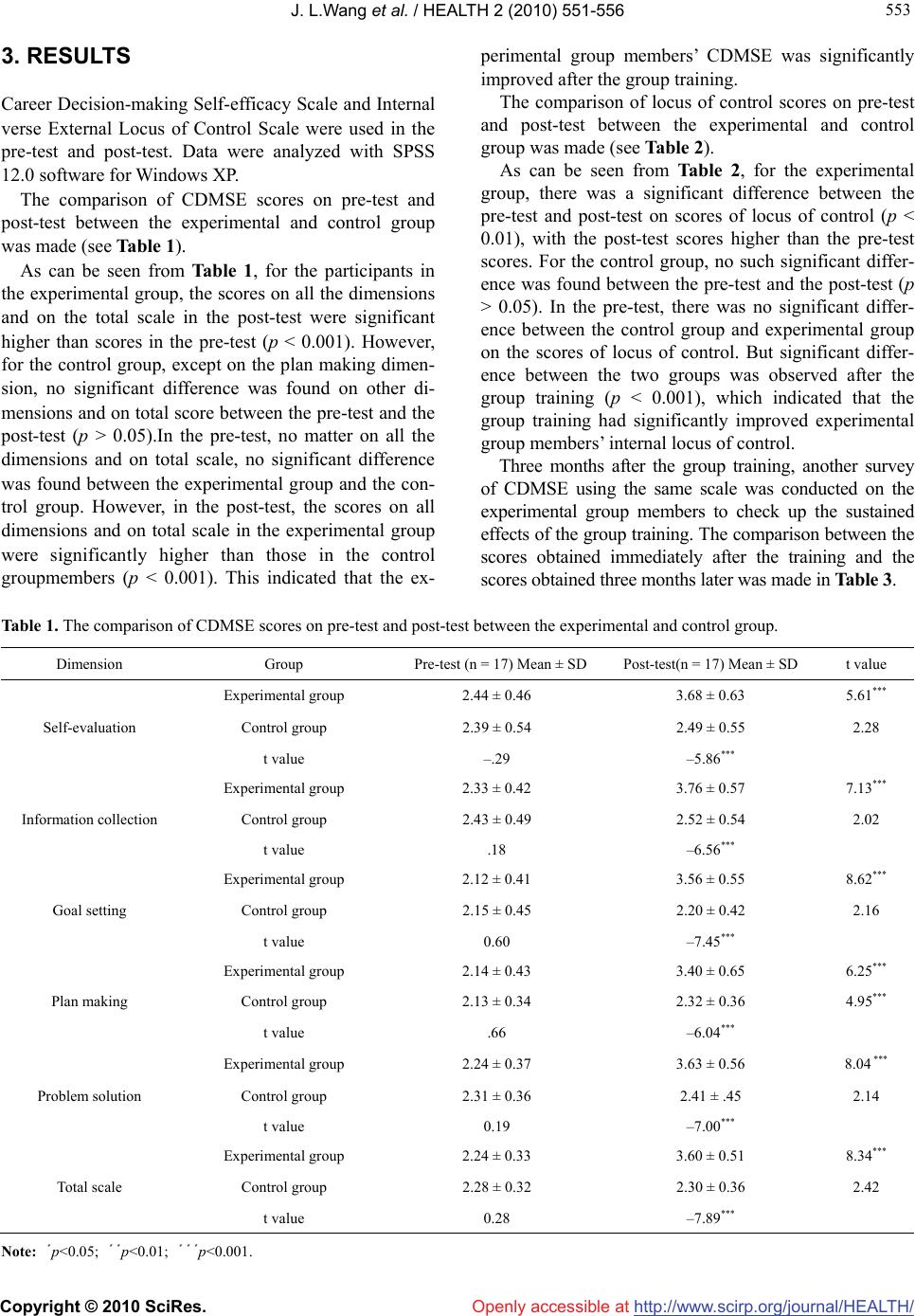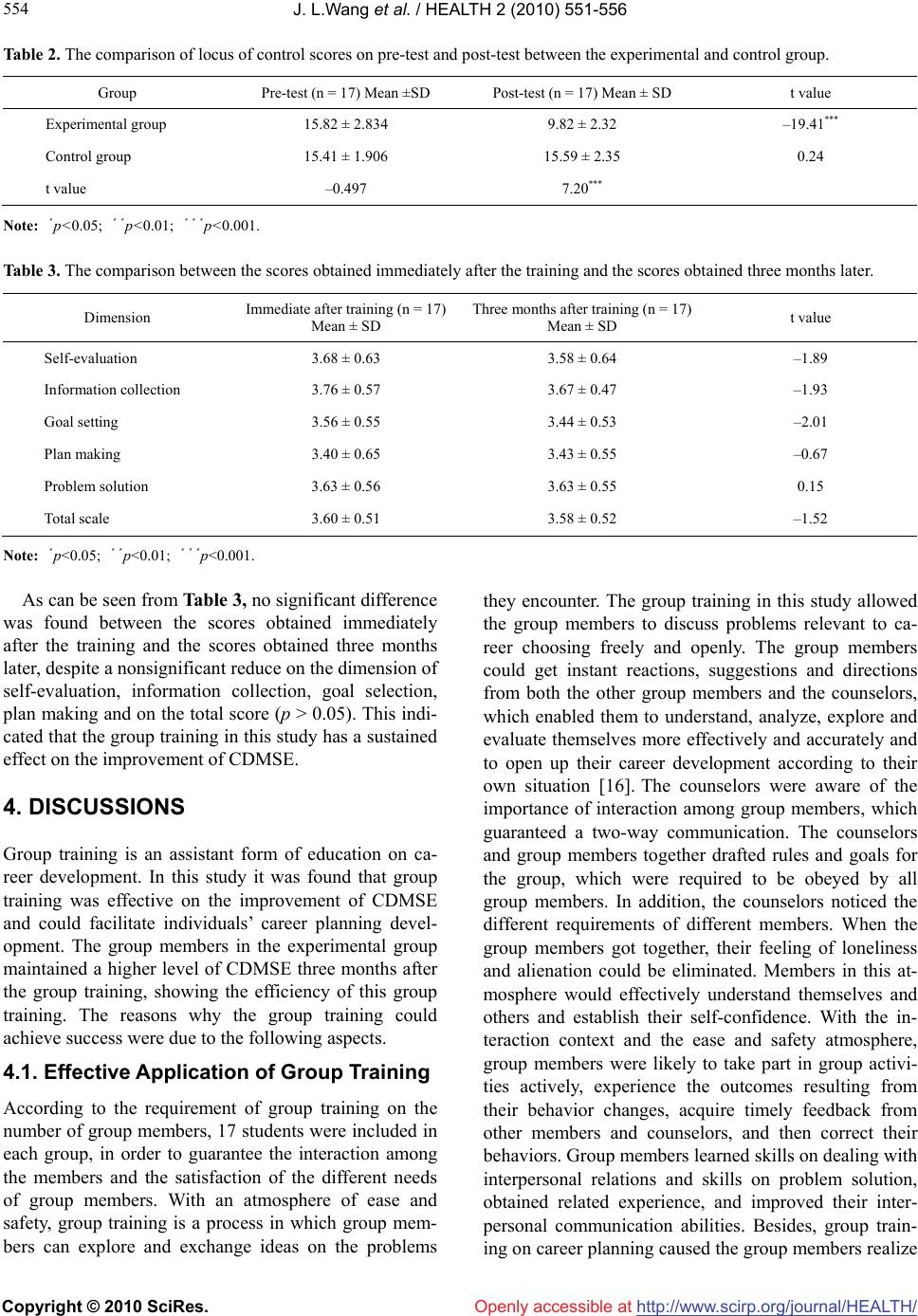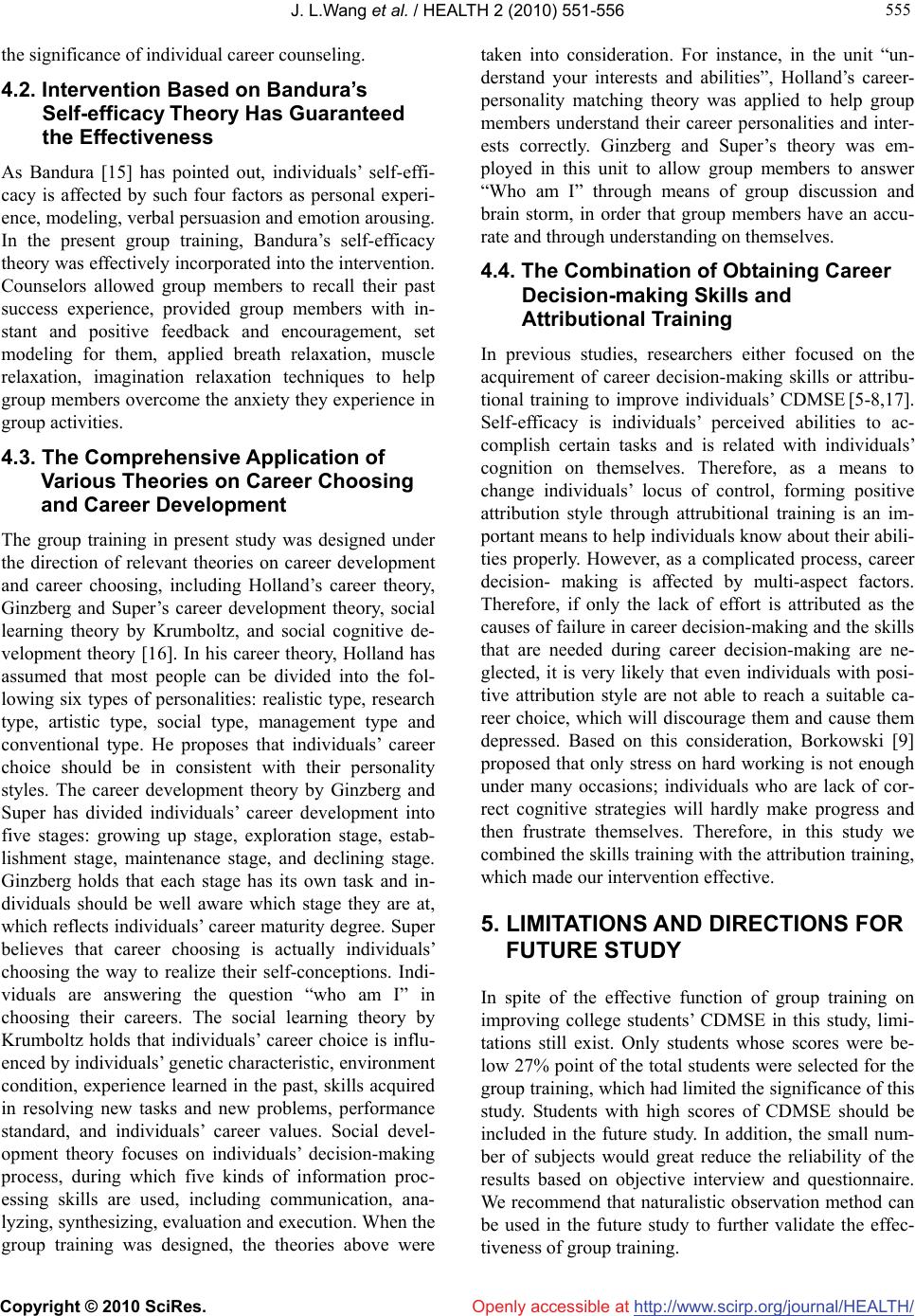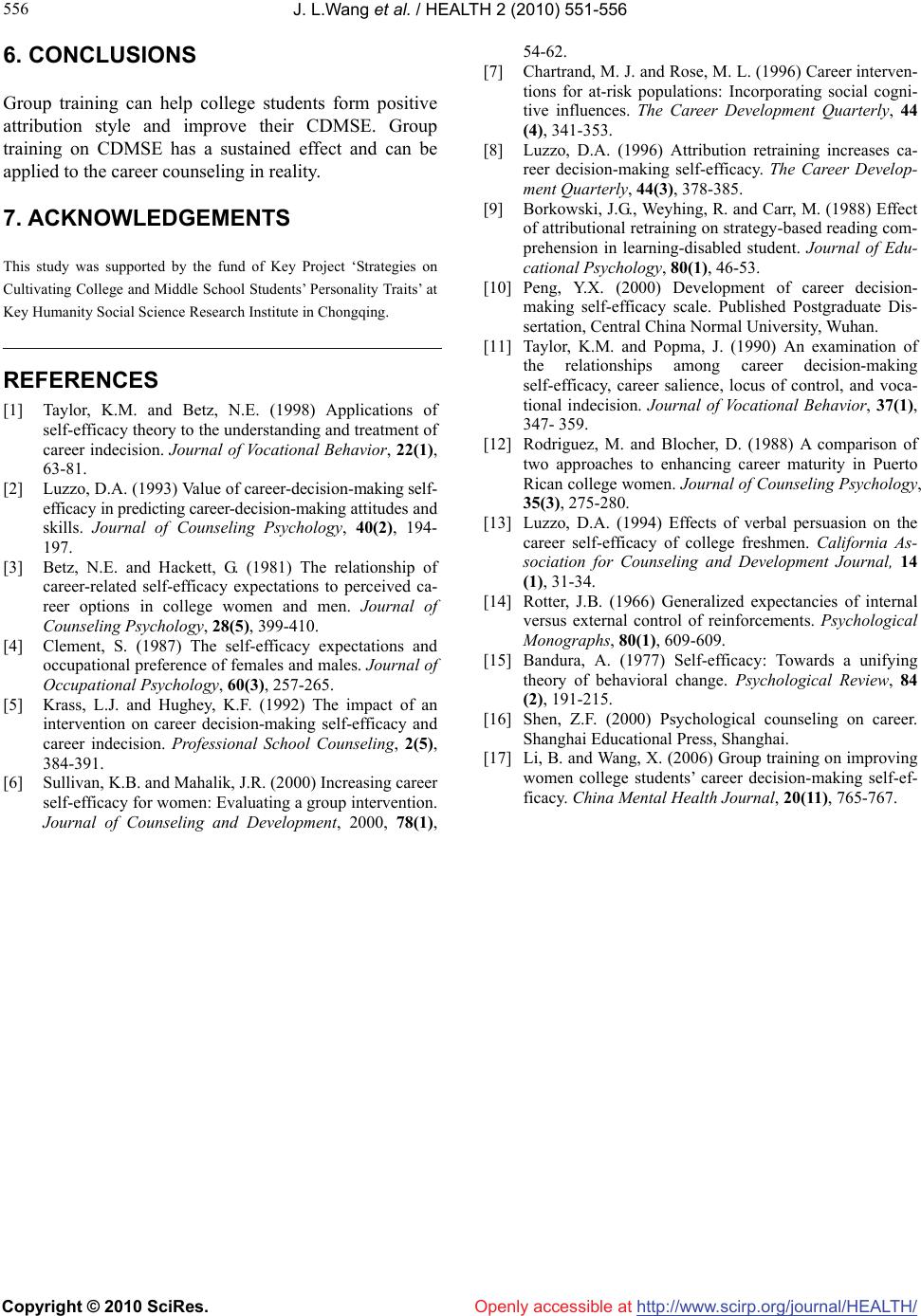Paper Menu >>
Journal Menu >>
 Vol.2, No.6, 551-556 (2010) Health doi:10.4236/health.2010.26082 Copyright © 2010 SciRes. Openly accessible at http://www.scirp.org/journal/HEALTH/ Group training on the improvement of college students’ career decision-making self-efficacy Jinliang Wang1,2, Dajun Zhang1,2*, Jingjin Shao3 1Center for Mental Health Education, Southwest University, Chongqing, China; *Corresponding Author: zhangdj@swu.edu.cn 2Research Institute of Educational Science, Southwest University, Chongqing, China 3Institute of Developmental Psychology, Beijing Normal University, Beijing, China Received 1 February 2010; revised 18 February 2010; accepted 21 February 2010. ABSTRACT A group training was conducted on 17 college students to improve their career decision-making self-efficacy (CDMSE). The result showed that there was significant difference between the pre-test and the post-test for the experimental group (n = 17), whereas no significant difference was found between the pre-test and the post- test for the control group (n = 17). In the pre-test, there was no significant difference between the experimental group and the control group, and obvious difference between the two groups was found in the post-test. This indicated that the group training was effective on improving the CDMSE of the college students whose scores of CDMSE were below 27% point of the total stu- dents. Keywords: College Student; Group Training; Attribution Training; Career Decision-Making Self-Efficacy 1. INTRODUCTION Career decision-making self-efficacy (CDMSE) is the specific application of self-efficacy theory in the domain of career studies. Based on Bandura’s self-efficacy the- ory and Crites’s career maturity theory, Taylor and Betz define CDMSE as the extent to which individuals’ be- lieve that they can evaluate themselves, collect career information, select goals, make plans, and resolve prob- lems relevant to career decision-making [1]. It has been found that CDMSE is of great importance to individuals career development. Individuals with higher level of CDMSE tend to be more active and positive in career decision-making, while individuals with lower level of CDMSE tend to be more passive and negative when choosing careers [2-4]. With the reform of college students’ employment sys- tem in China in late 1990s, college graduates have to make their career choices by themselves, instead of wait- ing to be distributed by the government. In this situation, students are likely to feel confused and dazed and think that they are not capable of selecting a suitable career for themselves. Under many occasions, many graduates with lower CDMSE choose jobs just for the salary or only based on their parents’ views, they usually choose some “hot” jobs beyond their abilities, interests and work val- ues and exclude jobs that are actually in consistent with their abilities and interests. Career decisions made in this way are not mature and often lead to individuals’ unsat- isfaction with their jobs and other negative emotions, and result in a negative impact on their career develop- ment. In addition, individuals with lower CDMSE usu- ally feel anxious and depressed during their career deci- sion- making and their mental health is negatively af- fected. Therefore, it is urgent and necessary to design intervention which can improve students’ decision- making self-efficacy. Group training is a kind of psychological counseling conducted in a group context. Through means of obser- vation, learning and experiencing during interpersonal interaction, group training enables individuals to explore, understand, and accept themselves, improve their inter- personal relationships, acquire new attitudes and behav- ioral styles, and develop good adaptation abilities. Group training has been found to be an effective way to im- prove college students’ CDMSE [5-8]. In group training, by using such means as helping group members re-ex- perience previous success, verbal persuasion, overcom- ing the anxiety occurring in career decision-making, providing modeling, and attributional training, counsel- ors assist group members in self-evaluation, career in- formation collection, goal setting, plan making, and so- lution of problems. However, little empirical studies based on the Chinese reality have been conducted on improving college students’ CDMSE, which has blocked  J. L.Wang et al. / HEALTH 2 (2010) 551-556 Copyright © 2010 SciRes. Openly accessible at http://www.scirp.org/journal/HEALTH/ 552 subsequent studies in the domain of CDMSE. Moreover, existing studies on CDMSE improvement were con- ducted either by teaching students career deci- sion-making skills or by attributional training, seldom studies have combined the two means. As argued by Borkowski, mere emphasis on individuals’ effort is not enough, because great effort can not necessarily lead to progress when individuals are directed by incorrect cog- nitive strategies, which will decrease individuals’ confi- dence [9]. Borkowski’s statement has implied the im- portance of both internal attribution and career decision- making skills. Therefore, in this study, we consider the combination of attributional training and skills acquire- ment to improve college students’ career decision-making self-efficacy. 2. METHOD 2.1. Participants Students were recruited from the Southwest University in China through poster advertising. Career Decision- making Self-efficacy Scale (CDMSE) was administrated to the recruited students [10]. Students’ scores on CDMSE scale were used as standard to select participants, 17 students whose scores were below 27% point of the total students were randomly selected into the experimental group (female = 12, male = 5), and another 17 students with the same condition were selected into the control group (female = 12, male = 5). No significant difference existed between the two groups on CDMSE. 2.2. Instrument 2.2.1. Career Decision-making Self-efficacy Scale On the basis of Career Decision-making Self-efficacy Scale by Betz and Taylor, according to the interview and open-ended questionnaire, Peng developed this 39 items Career Decision-making Self-efficacy Scale, which in- cluded five dimensions: self-evaluation, information collection, goal selection, plan making, and problem solution [10]. The internal consistent coefficients of each dimension were between .68 and .81, the internal con- sistent coefficient of the total scale was .94.The retest reliability of each dimension were between 0.51 and 0.60, the retest reliability of the total scale was 0.66. 2.2.2. Internal verse External Locus of Control Scale Individuals’ CDMSE was found to be significantly re- lated with their attributional style, with individuals with internal attribution having higher level of CDMSE while external attribution individuals having lower level of CDMSE. Attribution training has been shown to be effec- tive in improving individuals’ CDMSE [11-13]. Hence, in this study, we noticed the important role of positive at- tributional training and used the Internal verse External Locus of Control Scale as an assistant instrument. The Internal verse External Locus of Control Scale including 29 items in this study was developed by Rotter [14]. The score ranged from 0-23, with higher scores indicting higher level of external locus of control. The internal consistent coefficient was 0.70. 2.3. Intervention Program The design of the intervention program was based on career decision-making self-efficacy theory by Taylor and Betz [1], while Bandura’s self-efficacy theory [15], attribution theory, and other theories relevant to career were also taken into consideration. The whole interven- tion program can be divided into seven units, with each units owning a specific topic, including ‘know about your achievement’, ‘learn to search career information’, ‘understand your interest and ability’, ‘set career goals’, ‘plan your career’, ‘overcome difficulties’, and ‘take job applications’. The group training included the following activities and forms such as brain storm, role play, mod- eling, verbal persuasion, group discussion, and games, etc. During the group training, the experimenter noticed to provide group members with encouragement and di- rection, and to help them form positive attribution style. At the end of each session, the group members were asked to summarize their feelings towards the training. The experimenter created an acceptable and supportive atmosphere. Through group activities and interpersonal interaction, the group members could attempt to feel the positive experience, rebuild rational knowledge relevant to career choice, learn career decision-making skills, change their career-decision style from the improper and immature one to the proper and mature one, which can be used in realistic situation and therefore improve group members’ CDMSE. 2.4. Implementation Progress As a first step, assign participants into control group and experimental group. Based on the concrete situation of the experimental group members, we made modifica- tions on the initial intervention program in order to make the intervention more goal-directed and specific. Second, the group training was conducted one session each week, with each session lasting 90 minutes. The participants in the control group received on training. 2.5. Follow up Study The participants in the experimental group were investi- gated again 3 months after the end of CDMSE group training.  J. L.Wang et al. / HEALTH 2 (2010) 551-556 Copyright © 2010 SciRes. Openly accessible at http://www.scirp.org/journal/HEALTH/ 553 553 3. RESULTS Career Decision-making Self-efficacy Scale and Internal verse External Locus of Control Scale were used in the pre-test and post-test. Data were analyzed with SPSS 12.0 software for Windows XP. The comparison of CDMSE scores on pre-test and post-test between the experimental and control group was made (see Table 1). As can be seen from Table 1, for the participants in the experimental group, the scores on all the dimensions and on the total scale in the post-test were significant higher than scores in the pre-test (p < 0.001). However, for the control group, except on the plan making dimen- sion, no significant difference was found on other di- mensions and on total score between the pre-test and the post-test (p > 0.05).In the pre-test, no matter on all the dimensions and on total scale, no significant difference was found between the experimental group and the con- trol group. However, in the post-test, the scores on all dimensions and on total scale in the experimental group were significantly higher than those in the control groupmembers (p < 0.001). This indicated that the ex- perimental group members’ CDMSE was significantly improved after the group training. The comparison of locus of control scores on pre-test and post-test between the experimental and control group was made (see Table 2). As can be seen from Table 2, for the experimental group, there was a significant difference between the pre-test and post-test on scores of locus of control (p < 0.01), with the post-test scores higher than the pre-test scores. For the control group, no such significant differ- ence was found between the pre-test and the post-test (p > 0.05). In the pre-test, there was no significant differ- ence between the control group and experimental group on the scores of locus of control. But significant differ- ence between the two groups was observed after the group training (p < 0.001), which indicated that the group training had significantly improved experimental group members’ internal locus of control. Three months after the group training, another survey of CDMSE using the same scale was conducted on the experimental group members to check up the sustained effects of the group training. The comparison between the scores obtained immediately after the training and the scores obtained three months later was made in Table 3. Table 1. The comparison of CDMSE scores on pre-test and post-test between the experimental and control group. Dimension Group Pre-test (n = 17) Mean ± SD Post-test(n = 17) Mean ± SD t value Experimental group 2.44 ± 0.46 3.68 ± 0.63 5.61*** Self-evaluation Control group 2.39 ± 0.54 2.49 ± 0.55 2.28 t value –.29 –5.86*** Experimental group 2.33 ± 0.42 3.76 ± 0.57 7.13*** Information collection Control group 2.43 ± 0.49 2.52 ± 0.54 2.02 t value .18 –6.56*** Experimental group 2.12 ± 0.41 3.56 ± 0.55 8.62*** Goal setting Control group 2.15 ± 0.45 2.20 ± 0.42 2.16 t value 0.60 –7.45*** Experimental group 2.14 ± 0.43 3.40 ± 0.65 6.25*** Plan making Control group 2.13 ± 0.34 2.32 ± 0.36 4.95*** t value .66 –6.04*** Experimental group 2.24 ± 0.37 3.63 ± 0.56 8.04 *** Problem solution Control group 2.31 ± 0.36 2.41 ± .45 2.14 t value 0.19 –7.00*** Experimental group 2.24 ± 0.33 3.60 ± 0.51 8.34*** Total scale Control group 2.28 ± 0.32 2.30 ± 0.36 2.42 t value 0.28 –7.89*** Note: ﹡ p<0.05; ﹡﹡ p<0.01; ﹡﹡﹡ p<0.001.  J. L.Wang et al. / HEALTH 2 (2010) 551-556 Copyright © 2010 SciRes. Openly accessible at http://www.scirp.org/journal/HEALTH/ 554 Table 2. The comparison of locus of control scores on pre-test and post-test between the experimental and control group. Group Pre-test (n = 17) Mean ±SD Post-test (n = 17) Mean ± SD t value Experimental group 15.82 ± 2.834 9.82 ± 2.32 –19.41*** Control group 15.41 ± 1.906 15.59 ± 2.35 0.24 t value –0.497 7.20*** Note: ﹡ p<0.05; ﹡﹡ p<0.01; ﹡﹡﹡ p<0.001. Table 3. The comparison between the scores obtained immediately after the training and the scores obtained three months later. Dimension Immediate after training (n = 17) Mean ± SD Three months after training (n = 17) Mean ± SD t value Self-evaluation 3.68 ± 0.63 3.58 ± 0.64 –1.89 Information collection 3.76 ± 0.57 3.67 ± 0.47 –1.93 Goal setting 3.56 ± 0.55 3.44 ± 0.53 –2.01 Plan making 3.40 ± 0.65 3.43 ± 0.55 –0.67 Problem solution 3.63 ± 0.56 3.63 ± 0.55 0.15 Total scale 3.60 ± 0.51 3.58 ± 0.52 –1.52 Note: ﹡ p<0.05; ﹡﹡ p<0.01; ﹡﹡﹡ p<0.001. As can be seen from Table 3, no significant difference was found between the scores obtained immediately after the training and the scores obtained three months later, despite a nonsignificant reduce on the dimension of self-evaluation, information collection, goal selection, plan making and on the total score (p > 0.05). This indi- cated that the group training in this study has a sustained effect on the improvement of CDMSE. 4. DISCUSSIONS Group training is an assistant form of education on ca- reer development. In this study it was found that group training was effective on the improvement of CDMSE and could facilitate individuals’ career planning devel- opment. The group members in the experimental group maintained a higher level of CDMSE three months after the group training, showing the efficiency of this group training. The reasons why the group training could achieve success were due to the following aspects. 4.1. Effective Application of Group Training According to the requirement of group training on the number of group members, 17 students were included in each group, in order to guarantee the interaction among the members and the satisfaction of the different needs of group members. With an atmosphere of ease and safety, group training is a process in which group mem- bers can explore and exchange ideas on the problems they encounter. The group training in this study allowed the group members to discuss problems relevant to ca- reer choosing freely and openly. The group members could get instant reactions, suggestions and directions from both the other group members and the counselors, which enabled them to understand, analyze, explore and evaluate themselves more effectively and accurately and to open up their career development according to their own situation [16]. The counselors were aware of the importance of interaction among group members, which guaranteed a two-way communication. The counselors and group members together drafted rules and goals for the group, which were required to be obeyed by all group members. In addition, the counselors noticed the different requirements of different members. When the group members got together, their feeling of loneliness and alienation could be eliminated. Members in this at- mosphere would effectively understand themselves and others and establish their self-confidence. With the in- teraction context and the ease and safety atmosphere, group members were likely to take part in group activi- ties actively, experience the outcomes resulting from their behavior changes, acquire timely feedback from other members and counselors, and then correct their behaviors. Group members learned skills on dealing with interpersonal relations and skills on problem solution, obtained related experience, and improved their inter- personal communication abilities. Besides, group train- ing on career planning caused the group members realize  J. L.Wang et al. / HEALTH 2 (2010) 551-556 Copyright © 2010 SciRes. Openly accessible at http://www.scirp.org/journal/HEALTH/ 555 555 the significance of individual career counseling. 4.2. Intervention Based on Bandura’s Self-efficacy Theory Has Guaranteed the Effectiveness As Bandura [15] has pointed out, individuals’ self-effi- cacy is affected by such four factors as personal experi- ence, modeling, verbal persuasion and emotion arousing. In the present group training, Bandura’s self-efficacy theory was effectively incorporated into the intervention. Counselors allowed group members to recall their past success experience, provided group members with in- stant and positive feedback and encouragement, set modeling for them, applied breath relaxation, muscle relaxation, imagination relaxation techniques to help group members overcome the anxiety they experience in group activities. 4.3. The Comprehensive Application of Various Theories on Career Choosing and Career Development The group training in present study was designed under the direction of relevant theories on career development and career choosing, including Holland’s career theory, Ginzberg and Super’s career development theory, social learning theory by Krumboltz, and social cognitive de- velopment theory [16]. In his career theory, Holland has assumed that most people can be divided into the fol- lowing six types of personalities: realistic type, research type, artistic type, social type, management type and conventional type. He proposes that individuals’ career choice should be in consistent with their personality styles. The career development theory by Ginzberg and Super has divided individuals’ career development into five stages: growing up stage, exploration stage, estab- lishment stage, maintenance stage, and declining stage. Ginzberg holds that each stage has its own task and in- dividuals should be well aware which stage they are at, which reflects individuals’ career maturity degree. Super believes that career choosing is actually individuals’ choosing the way to realize their self-conceptions. Indi- viduals are answering the question “who am I” in choosing their careers. The social learning theory by Krumboltz holds that individuals’ career choice is influ- enced by individuals’ genetic characteristic, environment condition, experience learned in the past, skills acquired in resolving new tasks and new problems, performance standard, and individuals’ career values. Social devel- opment theory focuses on individuals’ decision-making process, during which five kinds of information proc- essing skills are used, including communication, ana- lyzing, synthesizing, evaluation and execution. When the group training was designed, the theories above were taken into consideration. For instance, in the unit “un- derstand your interests and abilities”, Holland’s career- personality matching theory was applied to help group members understand their career personalities and inter- ests correctly. Ginzberg and Super’s theory was em- ployed in this unit to allow group members to answer “Who am I” through means of group discussion and brain storm, in order that group members have an accu- rate and through understanding on themselves. 4.4. The Combination of Obtaining Career Decision-making Skills and Attributional Training In previous studies, researchers either focused on the acquirement of career decision-making skills or attribu- tional training to improve individuals’ CDMSE [5-8,17]. Self-efficacy is individuals’ perceived abilities to ac- complish certain tasks and is related with individuals’ cognition on themselves. Therefore, as a means to change individuals’ locus of control, forming positive attribution style through attrubitional training is an im- portant means to help individuals know about their abili- ties properly. However, as a complicated process, career decision- making is affected by multi-aspect factors. Therefore, if only the lack of effort is attributed as the causes of failure in career decision-making and the skills that are needed during career decision-making are ne- glected, it is very likely that even individuals with posi- tive attribution style are not able to reach a suitable ca- reer choice, which will discourage them and cause them depressed. Based on this consideration, Borkowski [9] proposed that only stress on hard working is not enough under many occasions; individuals who are lack of cor- rect cognitive strategies will hardly make progress and then frustrate themselves. Therefore, in this study we combined the skills training with the attribution training, which made our intervention effective. 5. LIMITATIONS AND DIRECTIONS FOR FUTURE STUDY In spite of the effective function of group training on improving college students’ CDMSE in this study, limi- tations still exist. Only students whose scores were be- low 27% point of the total students were selected for the group training, which had limited the significance of this study. Students with high scores of CDMSE should be included in the future study. In addition, the small num- ber of subjects would great reduce the reliability of the results based on objective interview and questionnaire. We recommend that naturalistic observation method can be used in the future study to further validate the effec- tiveness of group training.  J. L.Wang et al. / HEALTH 2 (2010) 551-556 Copyright © 2010 SciRes. Openly accessible at http://www.scirp.org/journal/HEALTH/ 556 6. CONCLUSIONS Group training can help college students form positive attribution style and improve their CDMSE. Group training on CDMSE has a sustained effect and can be applied to the career counseling in reality. 7. ACKNOWLEDGEMENTS This study was supported by the fund of Key Project ‘Strategies on Cultivating College and Middle School Students’ Personality Traits’ at Key Humanity Social Science Research Institute in Chongqing. REFERENCES [1] Taylor, K.M. and Betz, N.E. (1998) Applications of self-efficacy theory to the understanding and treatment of career indecision. Journal of Vocational Behavior, 22(1), 63-81. [2] Luzzo, D.A. (1993) Value of career-decision-making self- efficacy in predicting career-decision-making attitudes and skills. Journal of Counseling Psychology, 40(2), 194- 197. [3] Betz, N.E. and Hackett, G. (1981) The relationship of career-related self-efficacy expectations to perceived ca- reer options in college women and men. Journal of Counseling Psychology, 28(5), 399-410. [4] Clement, S. (1987) The self-efficacy expectations and occupational preference of females and males. Journal of Occupational Psychology, 60(3), 257-265. [5] Krass, L.J. and Hughey, K.F. (1992) The impact of an intervention on career decision-making self-efficacy and career indecision. Professional School Counseling, 2(5), 384-391. [6] Sullivan, K.B. and Mahalik, J.R. (2000) Increasing career self-efficacy for women: Evaluating a group intervention. Journal of Counseling and Development, 2000, 78(1), 54-62. [7] Chartrand, M. J. and Rose, M. L. (1996) Career interven- tions for at-risk populations: Incorporating social cogni- tive influences. The Career Development Quarterly, 44 (4), 341-353. [8] Luzzo, D.A. (1996) Attribution retraining increases ca- reer decision-making self-efficacy. The Career Develop- ment Quarterly, 44(3), 378-385. [9] Borkowski, J.G., Weyhing, R. and Carr, M. (1988) Effect of attributional retraining on strategy-based reading com- prehension in learning-disabled student. Journal of Edu- cational Psychology, 80(1), 46-53. [10] Peng, Y.X. (2000) Development of career decision- making self-efficacy scale. Published Postgraduate Dis- sertation, Central China Normal University, Wuhan. [11] Taylor, K.M. and Popma, J. (1990) An examination of the relationships among career decision-making self-efficacy, career salience, locus of control, and voca- tional indecision. Journal of Vocational Behavior, 37(1), 347- 359. [12] Rodriguez, M. and Blocher, D. (1988) A comparison of two approaches to enhancing career maturity in Puerto Rican college women. Journal of Counseling Psychology, 35(3), 275-280. [13] Luzzo, D.A. (1994) Effects of verbal persuasion on the career self-efficacy of college freshmen. California As- sociation for Counseling and Development Journal, 14 (1), 31-34. [14] Rotter, J.B. (1966) Generalized expectancies of internal versus external control of reinforcements. Psychological Monographs, 80(1), 609-609. [15] Bandura, A. (1977) Self-efficacy: Towards a unifying theory of behavioral change. Psychological Review, 84 (2), 191-215. [16] Shen, Z.F. (2000) Psychological counseling on career. Shanghai Educational Press, Shanghai. [17] Li, B. and Wang, X. (2006) Group training on improving women college students’ career decision-making self-ef- ficacy. China Mental Health Journal, 20(11), 765-767. |

